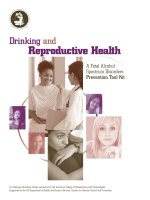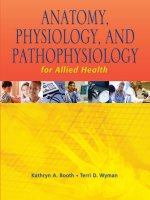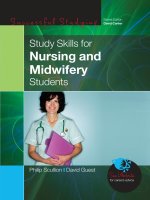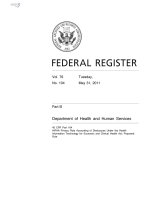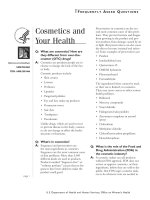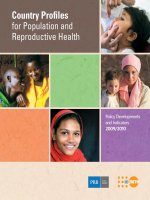Statistics for Nursing and Allied Health pot
Bạn đang xem bản rút gọn của tài liệu. Xem và tải ngay bản đầy đủ của tài liệu tại đây (3.91 MB, 434 trang )
LWBK083-3844G-FM_pi-xii.qxd 7/7/08 10:39 AM Page iv Aptara Inc.
Statistics
for Nursing and Allied Health
Stacey B. Plichta, ScD
Professor of Urban Public Health
Hunter College
The City University of New York (CUNY)
New York, New York
Laurel S. Garzon, PhD, PNP
Director
Graduate Nursing Programs
School of Nursing
Old Dominion University
Norfolk, Virginia
LWBK083-3844G-FM_pi-xii.qxd 7/7/08 10:39 AM Page i Aptara Inc.
Acquisitions Editor: Hilarie Surrena
Managing Editor: Helene T. Caprari
Senior Managing Editor / Production: Erika Kors
Director of Nursing Production: Helen Ewan
Art Director, Design: Holly McLaughlin
Art Director, Illustration: Brett MacNaughton
Manufacturing Coordinator: Karin Duffield
Senior Manufacturing Manager: William Alberti
Production Services / Compositor: Aptara, Inc.
Copyright © 2009 Wolters Kluwer Health | Lippincott Williams & Wilkins.
All rights reserved. This book is protected by copyright. No part of this book may be reproduced or
transmitted in any form or by any means, including as photocopies or scanned-in or other electronic
copies, or utilized by any information storage and retrieval system without written permission from the
copyright owner, except for brief quotations embodied in critical articles and reviews. Materials appearing
in this book prepared by individuals as part of their official duties as U.S. government employees are not
covered by the above-mentioned copyright. To request permission, please contact Lippincott Williams &
Wilkins at 530 Walnut Street, Philadelphia PA 19106, via email at or via website at
lww.com (products and services).
9 8 7 6 5 4 3 2 1
Printed in the United States of America
Library of Congress Cataloging-in-Publication Data
Plichta, Stacey Beth, 1965-
Statistics for nursing and allied health / Stacey B. Plichta, Laurel S. Garzon.
p. ; cm.
Includes bibliographical references and index.
ISBN–13: 978-0-7817-5459-0
ISBN–10: 0-7817-5459-3
1. Nursing—Research—Statistical methods. 2. Medical statistics. I. Garzon, Laurel S.
II. Title.
[DNLM: 1. Statistics as Topic—methods. 2. Nursing Research. WA 950 P728s 2009]
RT68.P65 2009
610.73072—dc22
2008024783
Care has been taken to confirm the accuracy of the information presented and to describe generally
accepted practices. However, the authors, editors, and publisher are not responsible for errors or
omissions or for any consequences from application of the information in this book and make no
warranty, expressed or implied, with respect to the currency, completeness, or accuracy of the contents of
the publication. Application of this information in a particular situation remains the professional
responsibility of the practitioner; the clinical treatments described and recommended may not be
considered absolute and universal recommendations.
The authors, editors, and publisher have exerted every effort to ensure that drug selection and
dosage set forth in this text are in accordance with the current recommendations and practice at the time
of publication. However, in view of ongoing research, changes in government regulations, and the constant
flow of information relating to drug therapy and drug reactions, the reader is urged to check the package
insert for each drug for any change in indications and dosage and for added warnings and precautions. This
is particularly important when the recommended agent is a new or infrequently employed drug.
Some drugs and medical devices presented in this publication have Food and Drug Administration
(FDA) clearance for limited use in restricted research settings. It is the responsibility of the health care
provider to ascertain the FDA status of each drug or device planned for use in his or her clinical practice.
LWW.COM
LWBK083-3844G-FM_pi-xii.qxd 7/7/08 10:39 AM Page ii Aptara Inc.
I would like to dedicate this book to my family for all of the love and support that
they have given me, especially to my mother, Patricia Plichta, my husband, Bill
Kellar, and my children, Jesse Carroll and Samantha Lee.
I would also like to thank all of my graduate students, who over the years have
helped to shape this book. I would like to give special thanks to two of my former
students, Dr. Yan Zhang and Mr. Paul Magnant, who spent many hours reading
drafts, developing homework exercises, and making this book more accessible to
students. My thanks also extend to another former student, YuQuin Zhao, who
provided a diligent and thorough review of our earlier drafts. Finally, I would like
to thank the editors at LWW, notably Helene Caprari, Michelle Clarke, and
Margaret Zuccarini, who with much patience and support have seen this project
through to completion.
Stacey B. Plichta
I would like to thank Beth and Anna for their love and Dot for my strength.
Laurel S. Garzon
Dedications
LWBK083-3844G-FM_pi-xii.qxd 7/7/08 10:39 AM Page iii Aptara Inc.
LWBK083-3844G-FM_pi-xii.qxd 7/7/08 10:39 AM Page iv Aptara Inc.
Reviewer List
Noori Akhtar-Danesh, MSc, PhD
Assistant Professor
McMaster University
Hamilton, Canada
Gina S. Brown, PhD, RN
Professor and Chair
Edyth T. James Department of Nursing
Columbia Union College
Takoma Park, Maryland
Bruce A. Cooper, PhD
Senior Statistician
Associate Adjunct Professor
University of California
San Francisco, California
Marcus Davey, PhD
Assistant Research Professor
Department of Surgery
Assistant Course Director
School of Nursing
University of Pennsylvania
Philadelphia, Pennsylvania
Rose Ann DiMaria-Ghalili, PhD, RN, CNSN
Associate Professor
West Virginia University
Morgantown, West Virginia
Willa Marlene Doswell, PhD, RN, FAAN
Associate Professor
University of Pittsburgh School of Nursing
Pittsburgh, Pennsylvania
Mary Beth Flanders, PhD, RN
Associate Professor
Fay Whitney School of Nursing
University of Wyoming
Laramie, Wyoming
David Anthony Forrester, PhD, RN
Professor
University of Medicine and Dentistry of New
Jersey
Newark, New Jersey
Simon Geletta, PhD
Assistant Professor
Des Moines University
Des Moines, Iowa
Beth S. Hembree, RN, MSN, DSN
Professor
Director of Graduate Studies
Lurleen B. Wallace College of Nursing
Jacksonville State University
Jacksonville, Alabama
LWBK083-3844G-FM_pi-xii.qxd 7/7/08 10:39 AM Page v Aptara Inc.
James E. Hodge, EdD
Professor of Mathematics
Mountain State University
Beckley, West Virginia
Ezra C. Holston, PhD, MSN, RN
Assistant Professor
University of California
Los Angeles, California
Ann F. Jacobson, PhD, RN
Associate Professor
Kent State University College of Nursing
Kent, Ohio
Tae Sook Kim, PhD
Associate Professor
Saint Joseph’s College
Brooklyn, New York
Rosalie O. Mainous, PhD, ARNP
Acting Associate Dean for Academic Affairs
University of Louisville
Louisville, Kentucky
Margaret E. Miller, PhD
Professor of Nursing
Bellarmine University
Louisville, Kentucky
Catherine Pearsall, PhDc, FNP, RN
Assistant Professor
Saint Joseph’s College
Patchogue, New York
Michael Perlow, DNS, RN
Professor of Nursing
Murray State University
Murray, Kentucky
Marjorie A. Pett, MStat, DSW
Research Professor
University of Utah College of Nursing
Salt Lake City, Utah
Sarah Ransdell, PhD
Associate Professor
Nova Southeastern University
Fort Lauderdale, Florida
Patsy L. Ruchala, DNSc, RN
Director
Orvis School of Nursing
University of Nevada
Reno, Nevada
Cynthia L. Russell, PhD, RN
Assistant Professor
University of Missouri-Columbia Sinclair School
of Nursing
Columbia, Missouri
Mina D. Singh, RN, PhD
Assistant Professor
York University
Toronto, Canada
Ida L. Slusher, RN, DSN
Professor
Eastern Kentucky University
Richmond, Kentucky
Sandra L. Smith, PhD, APRN
Assistant Professor
University of Utah
Salt Lake City, Utah
Darlene Steven, MHSA, PhD, PHN, RN
Professor and Coordinator
Lakehead University
Thunder Bay, Canada
Jessica L. Thomson, PhD
Statistician, Adjunct Professor
Louisiana State University Health Sciences
Center
Baton Rouge, Louisiana
Karen S. Ward, PhD, RN, COI
Professor and Associate Director of Online
Programs
Middle Tennessee State University
Murfreesboro, Tennessee
vi Reviewer List
LWBK083-3844G-FM_pi-xii.qxd 7/7/08 10:39 AM Page vi Aptara Inc.
Statistical analysis is an important tool in the conduct of clinical, basic, and out-
comes research in nursing and allied health. Nurses and allied health providers
with a focus on practice are best qualified to identify and develop research that
affects the delivery of care and patient outcomes. Current concerns about the
cost, quality, and equitable delivery (i.e., among all racial and ethnic groups) of
health care can be addressed by evidenced-based practices with measurable out-
comes of care.
Evidence-based practice is a process by which systematic inquiry is used to
explain or answer questions of interest. Research provides a process for careful,
organized, and thoughtful analysis and consideration of myriad evolving prob-
lems. Health care issues require an ongoing review and analysis of the congru-
ency of financial issues, personnel issues, methods of care, and outcomes.
A systematic research approach includes a step-by-step process of identifying
a problem or question, selecting the relevant variables, and then using the most
appropriate statistical method. This process can overwhelm beginners, but
approaching a research project in an organized way with the knowledge of the
basic statistics provided in this text can lead to a new and exciting understanding
of how powerful statistics can be. The choice of a particular statistical method
depends on the type of question asked (e.g., Are two or more things being com-
pared?), the variables selected (e.g., What are the important components of the
problem?), the level of measurement of the variables (e.g., What types of instru-
ments will be used?), and the level of certainty that is required. This text takes the
reader through this process. Readers will learn the language of statistics, how to
organize the data, and how to describe the data with simple statistics. This text
provides a good beginning to understand what data can reveal about research.
Preface
LWBK083-3844G-FM_pi-xii.qxd 7/7/08 10:39 AM Page vii Aptara Inc.
DEVELOPING RESEARCH AND STATISTICAL METHODS
Nursing research began in Florence Nightingale’s Notes of Nursing (1859). She
described the factors that she believed affected the outcomes of soldiers in the
Crimean war in a systematic way. Her notes provided the basis for a review of the
care these soldiers received, which, in turn, stimulated changes in nursing care
and public health.
Much of the research in the decades to follow was research about the education
of nurses. Sigma Theta Tau, the International Honor Society of Nursing, became
the first organization to fund nursing research in the United States, awarding a
research grant in 1936. In the 1930s, the American Journal of Nursing began pub-
lishing nursing research studies. In 1952, Nursing Research was created to share the
developing body of nursing studies. Today, this journal enjoys an international rep-
utation for being the foremost journal for peer-reviewed nursing research.
In the 1970s, the focus of research changed to the investigation of nursing
practice and the outcomes of nursing. The increased rigor required to investigate
practice-related issues required an in-depth knowledge of research design and sta-
tistical methods. Peer review was required for publication as additional journals,
such as Research in Nursing and Health and Advances in Nursing Science, were
developed to publish these studies. Clinical problems and issues related to practice
were identified as the foremost need for nursing research (Lindeman, 1975).
In 1986, the importance of nursing research was recognized with the estab-
lishment of the National Center for Nursing Research (NCNR), which is part of
the National Institutes of Health. This center provides funding for nursing
research and trains nurse researchers. The selection for funding developed into a
rigorous peer-reviewed process in which the design and statistical methods of
research projects are carefully reviewed. The funding provided by the NCNR has
grown to over $150 million annually. Current trends in nursing research are
focused on evidenced-based practice (Huddleston, Berkheimer, Landis, et al.,
2005; McCormick, Naimark, and Tate, 2006), increased rigor of studies (Im,
Page, Lin, Tsai, and Cheng, 2004; Sterling and Peterson, 2005), multidisciplinary
research, more visibility for nursing research, and a focus on culture and health
disparities (Peragallo, DeForge, O’Campo, et al., 2005).
ORGANIZATION OF THE CONTENT
The Role of Research in Health Care
In Chapter 1, “Using Research and Statistics in Health Care,” the role of research
in health care is explored. Research in nursing and allied health has contributed
viii Preface
LWBK083-3844G-FM_pi-xii.qxd 7/7/08 10:39 AM Page viii Aptara Inc.
to the development of practice guidelines and outcome measures. Examples of
research questions, designs, and specific statistical methods are discussed. This
chapter describes the 10 steps in building a research study plan and includes the
relationships among the research questions, study designs, and the selection of
the appropriate statistics.
Statistical Methods
Chapters 2 through 4 explain the foundations of data analysis, including the
process of understanding the data. In Chapter 2, “Descriptive Statistics: Getting
to Know the Data,” descriptive statistics are used to explain the collected data and
are illustrated with numerous examples. Descriptive statistics allow researchers,
for example, to generate reports about how many patients are receiving a drug,
the average daily dose, and the frequency of dosing. Chapter 2 will help readers
to organize and display descriptive data in a meaningful way. SPSS is used to
obtain frequency tables, descriptive statistics, and histograms. In Chapter 3,
“Building Blocks for Using Inferential Statistics,” the process for making infer-
ences or decisions based on statistical findings is depicted. Probability statistics is
discussed, and the usefulness of comparing the data to the normal (Gaussian) dis-
tribution is demonstrated. Readers will understand the process of making a
meaningful decision, using knowledge of sampling distribution, and estimating
means, z-scores, percentiles, and confidence intervals. In
Chapter 4, “Inferential
Statistics: Finding Relationships in the Data,” hypothesis testing is discussed.
Power analysis, selection of
p-values, and type I and type II errors are defined.
Comparing Means and Medians
Chapters 5 through 8 spell out the ways in which groups may be compared.
Chapter 5, “The Independent t-Test and the Mann-Whitney U-Test,” and Chapter
6, “The Paired t-Test and the Wilcoxon Matched-Pairs Test,” describe methods
for comparing the means and medians of two unrelated or related groups.
Chapter 7, “The One-Way ANOVA and the Kruskal-Wallis H-Test,” and Chapter
8, “The Repeated-Measures ANOVA and the Friedman’s ANOVA by Rank,”
describe methods for comparisons among three or more groups.
Examining Relationships Among Variables Using
Cross-Tabulation Tables and Correlation Coefficients
Chapter 9, “The Pearson and Spearman Correlation Coefficients,” and Chapter
10, “The Chi-Square Statistic and the McNemar Test,” describe the methods
used for examining relationships between continuous variables and relationships
between categorical variables. These methods include computing correlation
Preface ix
LWBK083-3844G-FM_pi-xii.qxd 7/7/08 10:39 AM Page ix Aptara Inc.
coefficients and constructing cross-tabulation tables. The cross-tabulation tables
are analyzed with the chi-square statistic, the Fisher’s exact test, and the
McNemar test.
Basic Model Building
Chapter 11, “Model Building With Linear and Logistic Regression,” provides an
introduction to the use of two multivariate models: multiple linear regression and
multiple logistic regression. The discussion includes an assessment of the overall
model and the interpretation of regression coefficients.
Dissemination of Findings
The purpose of research is to answer a question in a rigorous and meaningful way.
Chapter
12, “Writing for Publication,” explains the various methods for the dis-
semination of results. Methods for the presentation of findings in posters, oral
presentations, and journal articles are discussed.
Bibliography
Barnard, K. E., Wenner, W., Weber, B., Gray, C., & Peterson, A. (1977). Premature infant refo-
cus. In: Miller P. (Ed.), Research to practice in mental retardation, Vol. 3: Biomedical
aspects. Baltimore: University Park Press.
Huddleston, R., Berkheimer, C., Landis, S., Houck, D., Proctor, A., & Whiteford, J. (2005).
Improving patient outcomes in an ambulatory infusion setting. Journal of Infusion
Nursing, 28 (3), 170-172.
Im, E. O., Page, R., Lin, L. C., Tsai, H. M., & Cheng, C. Y. (2004). Rigor in cross-cultural nurs-
ing research. International Journal of Nursing Studies, 41 (8), 891-899.
Lindeman, C. A. (1975). Delphi survey of priorities in clinical nursing research. Nursing
Research, 24, 434–441.
McCormick, K., Naimark, B., & Tate, R. (2006). Uncertainty, symptom distress, anxiety and
functional status in patients awaiting coronary artery bypass surgery. Heart and Lung, 35
(1), 43–45.
Peragallo, N., DeForge, B., O’Campo, P., Lee, S., Kim, Y. J., Cianelli, R., & Ferrer, L. (2005).
A randomized clinical trial of an HIV-risk reduction intervention among low-income
Latina women. Nursing Research, 54, 108–118.
Sterling, Y. M., Peterson, J. W. (2005). Lessons learned from a longitudinal qualitative family
systems study. Applied Nursing Research, 18 (1), 44–49.
x Preface
LWBK083-3844G-FM_pi-xii.qxd 7/7/08 10:39 AM Page x Aptara Inc.
Contents
1
Using Research and Statistics in Health Care 1
2
Descriptive Statistics: Getting to Know the Data 20
3
Building Blocks for Using Inferential Statistics 59
4
Inferential Statistics: Finding Relationships in the Data 81
5
The Independent t-Test and the Mann-Whitney U-Test: Comparing
the Means of Two Unrelated Groups 102
6
The Paired t-Test and the Wilcoxon Matched-Pairs Test:
Comparing the Means of Two Related Groups 139
7
The One-Way ANOVA and the Kruskal-Wallis H-Test: Comparing the
Means of Three or More Unrelated Groups 171
8
The Repeated-Measures ANOVA and the Friedman’s ANOVA by Rank:
Comparing the Means of Three or More Related Groups 213
LWBK083-3844G-FM_pi-xii.qxd 7/7/08 10:39 AM Page xi Aptara Inc.
xii Contents
9
The Pearson and Spearman Correlation Coefficients:
Measuring the Association of Two Variables 260
10
The Chi-Square Statistic and the McNemar Test:
Examining Relationships Between Categorical Variables 291
11
Model Building With Linear and Logistic Regression 328
12
Writing for Publication 375
Appendix A Percent of Total Area of Normal Curve Between a z-Score and the Mean 385
Appendix B Critical Values of the Student t-Statistic 387
Appendix C Critical Values of “U” for the Mann-Whitney U-Test 389
Appendix D Critical Values of “T,” the Wilcoxon Signed-Rank Statistic 391
Appendix E Critical Values of “F” for Testing ANOVA Models 393
Appendix F Critical Values of “H” for the Kruskal-Wallis ANOVA by Rank 397
Appendix G Critical Values of Dunn’s Q for Nonparametric Multiple Comparison Testing 399
Appendix H Exact Distribution of the Friedman’s
r
2
for the Friedman’s ANOVA
by Rank Comparing Three Related Groups 400
Appendix I Significant Values of the Pearson Correlation Coefficient 402
Appendix J Critical Values of the Spearman Correlation Coefficient 404
Appendix K Significant Values of the Chi-Square Statistic 406
Glossary 408
Index 415
LWBK083-3844G-FM_pi-xii.qxd 7/7/08 10:39 AM Page xii Aptara Inc.
1
1
Using Research and
Statistics in Health Care
Learning Objectives
After studying this chapter, you should be able to:
1
Understand the role of research in developing knowledge for use in evidence-based
practice guidelines.
2 Discuss several ways that research can help policymakers.
3 Describe the differences between descriptive and inferential statistics.
4 Compose a study plan for the collection and analysis of data.
Nurses were at the forefront of the movement to use statistics to improve
health care. For example, Florence Nightingale (1820–1910) used data from
British army files to show how most of the deaths in the British army during
the Crimean War (1853–1856) were not caused by direct combat but by ill-
nesses contracted off the field of battle or as a result of unattended wounds.
Her statistical analyses convinced the British government to maintain field
hospitals and supply nursing care to soldiers. Nightingale passed her passion
for statistics on to her namesake, Florence Nightingale David, the eldest
daughter of her closest friends. Florence Nightingale David (1909–1995)
became a statistician and worked under Karl Pearson. She produced the first
edition of Tables of the Correlation Coefficient in 1938. During World War II,
Statistics are human beings with the tears wiped off.
■
Paul Brodeur, Outrageous Misconduct (1985).
LWBK083-3844G-01_p1-19.qxd 7/7/08 9:48 AM Page 1 Aptara Inc.
she used statistical models to help England prepare for German bombing raids.
David later left England for the United States and founded the Statistics
Department at the University of California, Riverside in 1970 (Salsburg, 2001).
UNDERSTANDING THE ROLE OF EMPIRICAL RESEARCH
Nurses and allied health professionals need a solid understanding of how empirical
knowledge is generated because evidence-based practice has become the standard
by which clinical guidelines are produced (Andrews and Redmond, 2004;
McNaughton et al., 2004; Polit and Beck, 2008; Stevens, 2001). The widespread use
of clinical guidelines since the 1980s has led to significant improvements in the out-
comes of health care (Ahlqvist et al., 2006; Brooks, 2004; Penney and Foy, 2007).
These guidelines depend on a systematic review of the research evidence (Stevens,
2001), which, in turn, requires a sound understanding of statistics and research
methods (Klardie, Johnson, McNaughton, and Meyers, 2004; Meyers, Johnson,
Klardie, and McNaughton, 2004). The Cochrane Collaboration produces the largest
collection of clinical guidelines (Cochrane Collaboration, 2007). This international
nonprofit organization was founded in 1993 to develop and disseminate systematic
reviews of health care interventions. In the United States, the U.S. Preventive
Services Task Force (U.S. Preventive Services Task Force, 2007) has assumed pri-
mary responsibility for developing evidence-based guidelines for health care.
An example of an evidence-based clinical guideline concerns the use of bed
rest for back pain (Hagen et al., 2005). Through a systematic review of the litera-
ture, Hagen and coworkers concluded that for people with acute low back pain,
bed rest is less effective than staying active. They also concluded that for patients
with sciatica, there is little or no difference in outcomes among those who stay
active and those who rest in bed. Advances in nursing and allied health depend on
practitioners such as Hagen and coworkers who develop guidelines based on
empirical research. These studies, which are conducted by fellow clinicians, are
most likely to be relevant to developing clinical guidelines (McCormack, 2003).
Taking a leading role in research, however, demands an understanding of how to
conduct empirical research, including competency in statistics.
Research can also help policymakers to identify health care problems that
may lend themselves to policy solutions. For example, the ongoing nursing short-
age is predicted to last for 10 years or more because of a number of demographic,
environmental, and professional factors (Auerbach, Buerhaus, and Staiger, 2007).
Health care organizations have responded to this shortage by encouraging the
immigration of foreign nurses and calling for more graduates from nursing
schools (Brush, Sochalski, and Berger, 2004). It appears, however, that some
health care organizations are less concerned with the educational level of nurses
2 Statistics for Nursing and Allied Health
LWBK083-3844G-01_p1-19.qxd 7/7/08 9:48 AM Page 2 Aptara Inc.
and more concerned with simply having more nurses of any educational back-
ground (e.g., ADN, diploma, BSN).
The question suggested by this solution to the nursing shortage—Does the
level of education of nurses in a given hospital affect patient outcomes?—was
studied by a team of nurse, medical, and sociologic researchers, and the results
were published in the Journal of the American Medical Society after extensive
peer review (Aiken, Clarke, Cheung, Sloane, and Silber, 2003). The findings of
this study indicate that a 10% increase in the proportion of hospital nurses with
baccalaureate degrees is associated with a 5% decline in mortality after common
surgical procedures. The researchers used advanced statistical models to account
for many factors, other than the nurses’ education, that might explain the varia-
tion in hospital death rates. In addition to the educational preparation of these
nurses, the study also took into account how ill patients were on admission, the
size of the hospital, the technological capacity of the hospital, whether or not it
was a teaching facility, the board certification of the attending surgeons, and
patient-to-nurse staffing ratios. Even after statistically controlling for all of these
factors, there was a clear positive effect of nurse education level on quality of
care. These findings determined that the level of nursing education is critical and
that increasing the number of nurses without concern for educational level has
serious implications for critically ill patients.
TYPES OF RESEARCH STUDIES AND STATISTICS
Research studies serve many different purposes. Polit and Beck (2008) described
the four main purposes of empirical research: description, exploration, explana-
tion, and prediction and control (considered one category). In general, empirical
studies use two different categories of statistics: descriptive and inferential.
Descriptive statistics are simply numerical or graphical summaries of data,
including charts, graphs, and simple summary statistics such as means and stan-
dard deviations, used to describe characteristics of a population sample.
Inferential statistics are statistical techniques (e.g., chi-square test, the t-test, the
one-way ANOVA) that allow conclusions to be drawn about the relationships
found among different variables in a population sample. The one-sample z-test,
another example of inferential statistics, allows a comparison of sample data with
a larger population.
Descriptive Studies and Descriptive Statistics
Studies whose primary purpose is descriptive and explorative simply describe sit-
uations and events. These studies use descriptive questions, such as: What is the
Chapter 1 Using Research and Statistics in Health Care 3
LWBK083-3844G-01_p1-19.qxd 7/7/08 9:48 AM Page 3 Aptara Inc.
marital status of people in the United States? or What is the average length of
stay in the hospital after being admitted for an asthma attack? Descriptive sta-
tistics are typically used to analyze data from this type of study (see Chapter 2
for more information about descriptive statistics).
Table 1-1 illustrates the use
of descriptive statistics to answer the question about the marital status of
women in the United States by using data from the U.S. Census Bureau (U.S.
Census Bureau, 2000). As shown in Table 1-1, in the year 2000, approximately
52.1% of women were currently married, 24.1% had never married, 10.8%
were divorced, 2.5% were separated, and 10.5% were widowed (U.S. Census
Bureau, 2000).
Explanatory Studies and Inferential Statistics
Studies whose primary purpose is explanatory elucidate the relationships among
variables. These studies are typically more complex than descriptive studies.
Their questions and lines of inquiry are often based on established theories from
the research literature. Explanatory studies depend on inferential questions, such
as: Are women who are sedentary during the third trimester of pregnancy more
likely to have a cesarean section (C-section) than women who exercise regularly
during the third trimester? or Are people with health insurance more likely to
have a longer hospital stay after being admitted for an asthma attack than people
without health insurance? Explanatory studies do not necessarily attempt to
establish causality but often attempt to understand how variables are related to
each other. Inferential statistics are used to examine the relationship among vari-
ables in an explanatory study (see Chapters 4 to 11 for more information about
inferential statistics).
An example of an explanatory study is one conducted by Ludwig-Beymer and
Gerc (2002), who examined the relationship between exercise behavior and
receiving the flu vaccine in a sample of 999 health care workers.
Table
1-2 shows
4 Statistics for Nursing and Allied Health
TABLE 1-1
MARITAL STATUS OF U.S. WOMEN
AGE 15 YEARS AND OLDER
STATUS PERCENT
Currently married 52.1
Single 24.1
Divorced 10.8
Separated 2.5
Widowed 10.5
Source: U.S. Census Bureau. (2000). (http://factfinder.census.gov).
LWBK083-3844G-01_p1-19.qxd 7/7/08 9:48 AM Page 4 Aptara Inc.
the data from this study in a cross-tabulation table. A cross-tabulation table is a
way to graphically display the relationship between two variables. Table 1-2 shows
that 46.8% of the health care workers who exercised regularly received the
influenza vaccine compared with 53.2% of those who did not exercise regularly.
Even though these numbers are not identical, chi-square analysis indicates that
they are not statistically different, meaning that the two groups did not signifi-
cantly differ in their likelihood of obtaining the influenza vaccine, and any appar-
ent differences are
attributable to chance (see Chapter 10 for more information
about chi-square analysis).
Prediction and Control Studies and Inferential Statistics
Prediction and control studies seek to determine which variables are predictive
and to determine causality (e.g., one event causes another to happen). Prediction
and control studies are typically quasi-experimental or experimental studies in
which researchers introduce an intervention. True experimental designs include
random selection, an intervention, one or more control groups that do not
receive the intervention, and random assignment of the study participants to
either the control group(s) or the intervention group. Quasi-experimental
designs are similar to experimental designs except that they lack one or more of
the following: random selection into the study, a true control group, or random
assignment to the intervention or control groups (Polit, 2008). In health-related
research, quasi-experimental designs are often used. As with explanatory studies,
quasi-experimental studies typically use inferential statistics to analyze the data
and answer the research questions.
Chapter 1 Using Research and Statistics in Health Care 5
TABLE 1-2
RELATIONSHIP OF REGULAR EXERCISE TO OBTAINING A FLU
VACCINATION IN 999 HEALTH CARE WORKERS
RECEIVED FLU VACCINATION
n (%) n (%) ROW TOTALS
Regular Exercise Yes No Number in each
gender group
Yes 235 (46.8) 254 (51.1) 489
No 267 (53.2) 243 (48.9) 510
Column totals 502 497 999
(number in each
vaccination group)
Note. Chi-square p Յ .18 (not statistically significant).
Source: Data from Ludwig-Beymer P, & Gerc SC. (2002). An influenza prevention campaign: the employee
perspective. Journal of Nursing Care Quality, 16 (3), 1–12.
LWBK083-3844G-01_p1-19.qxd 7/7/08 9:48 AM Page 5 Aptara Inc.
TEN STEPS TO BUILDING A STUDY PLAN
All studies, no matter what the purpose, need to be well-planned. For example, in
studies in which many variables are measured, it is easy to lose track of the initial
purpose of the study and to generate “results” that appear to be useful. These
results, however, are meaningless unless they exist in the context of an organized
line of inquiry. Box
1-1 lists some of the common mistakes researchers make
when embarking on research projects. These mistakes are often made when there
is no study plan or when the plan is insufficiently detailed. Papers resulting from
studies that have inadequate study plans often lack focus and clarity. Although
several well-known methods for writing a study plan are available, they all follow
the same basic principles. A typical approach is described below.
A study plan is a written presentation of how the researcher is going to obtain
and analyze the numerical data needed to answer the research questions. A good
study plan keeps the analysis focused and relevant. It serves as the basis for the
introduction and methods section of research papers after the data have been col-
lected and analyzed. A study plan can also serve as the basis for the first three
chapters of a dissertation or thesis. In addition, most grants require study plans
similar to the one presented here.
The outline that a study plan should follow is summarized in
Box
1-2 and
described on the following page. The method presented here is fairly standard,
and similar ones can be found in guides to planning research (Ogden and
Goldberg, 2002; Wood, 2006). A study plan begins with a statement of the prob-
lem that the study is trying to solve (i.e., the purpose of the study) and a short
6 Statistics for Nursing and Allied Health
EIGHT COMMON MISTAKES IN RESEARCH
1. Undertaking a research project without reviewing the existing literature on the subject
2. Collecting data without a well-defined plan, hoping to make sense of it afterwards
3. Trying to fit meaningful research questions to existing data
4. Defining terms in general or ambiguous language
5. Failing to base research on a sound theoretical foundation
6. Failing to make explicit and clear the underlying assumptions
7. Failing to recognize the limitations of the approach
8. Failing to anticipate rival hypotheses that would account for findings and that challenge
interpretations and conclusions
Source: Courtesy of Dr. Brenda Nichols, Dean of the College of Arts and Sciences, Lamar University, Beaumont,
Texas.
BOX 1-1
LWBK083-3844G-01_p1-19.qxd 7/7/08 9:48 AM Page 6 Aptara Inc.
description of the significance of the problem. The statement of purpose is the
guiding force behind the entire research project, and the study should flow from
it. A study plan also needs a theoretical or conceptual framework on which
research questions and hypotheses are based. This framework presents a struc-
tured way of thinking about the interrelationships of the variables. Research
questions are either very specific or broadly conceptual. The hypotheses, how-
ever, must be very specific because they provide the guide for the analysis of the
data. The study plan should define key terms and variables, provide a brief
description of the research design, and describe the sample and how it was
obtained. The plan should also state the statistical techniques that will be used to
test each hypothesis. A good study plan lists any major assumptions and limita-
tions of the study being described. And finally, a good study plan contains a brief
description of how the data obtained from the study will be disseminated.
Statement of the Problem and Its Significance
A study plan starts with a clear explanation of the purpose of the study and the sig-
nificance of the problem to be studied. This explanation should include the rea-
sons why the study is important and how the study fits into the existing body of
research. This section orients researchers and interested readers to the study.
The statement of the problem should be no more than two or three sentences,
and should clearly articulate what the study is seeking to accomplish. The ratio-
nale for the study should include a brief overview of the epidemiology of the
problem being addressed. It should also include a discussion of the monetary and
nonmonetary costs of the problem to society, to the health care system, and to
people who have the problem. It should also provide a review of other studies in
Chapter 1 Using Research and Statistics in Health Care 7
TEN-STEP STUDY PLAN
1. Statement of the problem and its significance
2. Theoretical or conceptual framework
3. Research questions to be answered by the study
4. List of hypotheses to be tested
5. Definitions of key terms and variables
6. Description of the research design
7. Description of the sample and how it was obtained
8. Description of the planned statistical analysis
9. Statement of assumptions and limitations
10. Dissemination plan
BOX 1-2
LWBK083-3844G-01_p1-19.qxd 7/7/08 9:48 AM Page 7 Aptara Inc.
the literature that have examined similar issues. The rationale should then explain
the weaknesses in the literature (e.g., what is not well documented, what is not
known at all) and how the current study will add to the existing knowledge base.
An example of a statement of the problem follows:
The purpose of the study on maintaining physical behavior is to examine
the development of exercise habits over a 12-week period and to test the
ability of the theory of planned behavior to predict actual participation in
physical activity (Armitage, 2005).
Theoretical or Conceptual Framework
All studies need to have an underlying framework that organizes the analysis
by stating how all of the variables are expected to relate to one another. In writ-
ing a thesis or dissertation, this is accomplished by using (and testing) a theo-
retical model from the research literature. Theses and dissertations typically
test and draw conclusions about the validity of theories that already exist in the
literature. Even beyond the thesis and dissertation stage, models are vital.
Models can keep the analyses organized and coherent. They provide a logical
framework that connects the variables to each other and that helps to establish
the relative importance of each variable in predicting the outcome. For exam-
ple, when testing an intervention, the logical model being tested is that the
intervention will affect health status or health behavior variables. Other fac-
tors, such as age and gender, are also expected to affect health status. A good
model provides a framework that outlines the expected relationships among
different variables.
Numerous theories are used in nursing research. Many of these theories are
disease specific. However, several theoretical models are useful both in nursing
and across disciplines. The three models discussed here are examples of theories
that can facilitate empirical work: Andersen’s model of health care use, the theory
of unpleasant symptoms, and the theory of planned behavior.
Anderson’s Model of Health Care Use
Andersen’s model of health care use postulates that the use of health services is a
function of the perceived need for care, predisposing factors (e.g., cultural fac-
tors), and factors that enable patients to obtain care (e.g., knowledge, insurance)
(Andersen, 1995). For example, in using Andersen’s model to study condom use
among adolescents, having easy access to condoms is viewed as an “enabling fac-
tor.” The effect of easy access to condoms on condom use would be examined in
the context of other factors discussed in the model, such as predisposing factors
(e.g., age, gender) and need factors (e.g., adolescents’ perceived need for contra-
ception).
8 Statistics for Nursing and Allied Health
LWBK083-3844G-01_p1-19.qxd 7/7/08 9:48 AM Page 8 Aptara Inc.
Theory of Unpleasant Symptoms
The Theory of Unpleasant Symptoms is another useful theory in research related
to health care (Lenz, Pugh, Milligan, Gift, and Suppe, 1997). This theory postu-
lates that symptoms do not occur in isolation, meaning that the effects of symp-
toms that occur at the same time are multiplicative and not simply additive. This
nursing model includes four dimensions for each symptom: severity or intensity,
distress, quality, and time. Two additional components have been recently added
to the model: factors that influence the symptom experience and the conse-
quences of the symptom experience. In general, the model postulates that
fatigue, pain, and impaired functioning are related to experiencing symptom clus-
ters. Among the many studies that have supported this model are studies of post-
partum fatigue in military women (Rychnovsky, 2007), postoperative pain in chil-
dren recovering from tonsillectomies (Huth and Broome, 2007), and fatigue in
hemodialysis patients (Liu, 2006). Based on this model, Gift and coworkers
(2003) examined the effect of time on symptom clusters in patients with lung can-
cer. The model supported the fact that the symptom cluster was predicted to
remain over the course of having lung cancer. The symptom cluster over time was
an independent predictor of the patient’s death.
Theory of Planned Behavior
A theory often used in the research of individual health behavior and behavioral
intentions is the theory of planned behavior (Ajzen, 1991). According to this the-
ory, the performance of any behavior depends on behavioral intention. Behavioral
intention is viewed as being dependent on behavioral beliefs (e.g., attitude
towards the behavior), normative beliefs, and control beliefs. Attitudes are
described as being the disposition toward the behavior. Normative beliefs are
beliefs about the expectations of others, and control beliefs are beliefs about the
factors that may help or hinder the performance of the behavior. The framework
for the study of physical activity discussed earlier by Armitage (2005) is based on
this theory. This study found that behavioral beliefs, normative beliefs, and con-
trol beliefs all contribute to physical activity behavior.
Research Questions to Be Answered by the Study
Research questions should stem directly from the statement of the problem and
the theoretical framework on which it is based. It is also important to ground
research questions in the existing literature. (This is where the significance sec-
tion can be useful.) Research questions should be clear about the relationships
that are expected. Additionally, the research questions must relate directly to the
data that will be collected by the researcher. For example, it does not make sense
to have a research question that asks about the relationship of drinking to exercise
Chapter 1 Using Research and Statistics in Health Care 9
LWBK083-3844G-01_p1-19.qxd 7/7/08 9:48 AM Page 9 Aptara Inc.
behavior if data about alcohol use are not collected. Research questions asked in
Armitage (2005) are listed below.
Descriptive Questions
■ What is the level of intention to engage in physical activity among a group of
adults that recently joined a fitness facility?
■ What is the actual level of physical activity among a group of adults that
recently joined a fitness facility?
Inferential Questions
■ Does attitude toward exercise affect participation in physical activity?
■ Does the extent to which participants perceive themselves as able to exercise
(perceived behavioral control) affect participation in physical activity?
■ Do subjective norms affect participation in physical activity?
■ Does intention to exercise predict physical activity?
List of Hypotheses to Be Tested
A hypothesis is a tentative prediction or explanation of the relationship between
two or more variables. The purpose of a hypothesis is to translate problem state-
ments and research questions into predictions of expected outcomes. The
hypotheses, therefore, must stem directly from the research questions and the
problem statement and be grounded in the theoretical framework that is chosen.
A hypothesis states the expected relationship between the variables. This rela-
tionship can be either an association in which no causal effect is presumed or a
causal relationship in which one variable (the independent variable) is expected
to cause changes in the other variable (the dependent variable). In most cases, the
hypotheses stated are directional, that is, they are specific statements of the direc-
tion of the relationship between two variables. The hypothesized direction of the
relationship can be either direct or inverse. In a direct relationship, the depen-
dent variable increases as the independent variable also increases. In an inverse
relationship, the dependent variable decreases in value as the independent vari-
able increases in value. The “direction of the relationship” should be based on the
chosen theory and findings from previous research. If there are no previous find-
ings, it is permissible to base hypotheses on expert opinion or a sound rationale.
In a research plan, the hypotheses serve as the guide for data analysis. There
should be a specific hypothesis for each relationship that is being tested. In a dis-
sertation, it is not unusual, for example, to have 30 or 40 hypotheses that are being
tested. Of course, many of these can be grouped under headings (e.g., sociodemo-
graphic characteristics, physical activity). New researchers should be especially
10 Statistics for Nursing and Allied Health
LWBK083-3844G-01_p1-19.qxd 7/7/08 9:48 AM Page 10 Aptara Inc.
careful to write down each relationship that they plan to test to stay organized and
focused. Hypotheses tested by Armitage (2005) include the following:
■ Those who perceive themselves as being able to exercise will be more likely to
engage in physical activity than those who do not.
■ Those who perceive subjective norms that are supportive of exercise are more
likely to exercise.
■ Those with a positive behavioral intention to exercise are more likely to do so
than those without a positive behavioral intention to exercise.
Definitions of Key Terms and Variables
In a research plan, it is important to clearly define key terms and variables. Terms are
best defined when they first appear so that readers do not initially make assumptions
about definitions only to discover later that different definitions apply. It is especially
important to define terms that readers outside the field of study may not understand.
And finally, it is important to include units of measure in the definitions.
The variables used in a study must stem directly from the hypotheses.
Specifically, variables should measure most, if not all, of the constructs discussed
in the conceptual or theoretical model. Furthermore, it should be clearly indi-
cated which variables are independent and which are dependent. Independent
variables are those that are manipulated (i.e., by the intervention) or that may
affect the outcome. Variables such as age, income, and preexisting health condi-
tions are usually considered independent variables. Dependent variables are
those that are expected to change in response to the interventions, such as health
status, number of visits to the doctor, and costs of inpatient stay. Some examples
of variables used by Armitage (2005) include the following:
■ Self-reported physical activity is defined as the participants’ self-report of how
many times they participated in physical activity in the past 3 months (rated
on a 7-point scale that ranged from never to frequently).
■ Perceived behavioral control is defined by averaging responses for four Likert
scale items (responses ranged from 1 to 7; high scores indicate greater levels of
perceived behavioral control). The scale items were:
1. To what extent do you see yourself as being capable of participating in phys-
ical activity? (incapable–capable)
2. How confident are you that you will be able to participate in regular physi-
cal activity? (not very confident–very confident)
3. I believe I have the ability to participate in regular physical activity. (defi-
nitely do not–definitely do)
4. How much personal control do you feel you have over participating in regu-
lar physical activity? (no control–complete control).
Chapter 1 Using Research and Statistics in Health Care 11
LWBK083-3844G-01_p1-19.qxd 7/7/08 9:48 AM Page 11 Aptara Inc.

